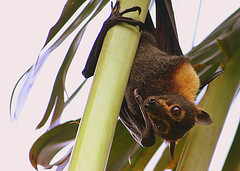
Australian bat lyssavirus (ABLV) is related to the rabies virus. Thankfully, lyssavirus is a rare disease in Australia and only three human deaths have been recorded since it was discovered in 1996.
People can be infected by bites or scratches from infected flying foxes or bats. There are vaccines to prevent infection and treatment after direct exposure can also be effective. It is important to seek treatment promptly if you have had contact with bats.
If you are bitten or scratched by a bat, immediately wash the wound thoroughly with soap and water, apply an antiseptic and get immediate medical help.
Fast facts:
- Australian bat lyssavirus is closely related to the rabies virus.
- Infections are rare in Australia.
- Exposure to blood urine or faeces is not known to transmit infection.
- The virus can be transmitted to humans by bites or scratches from infected bats.
- If bitten by a bat or flying fox, wash the wound thoroughly with soap and water. Apply antiseptic to the area and seek medical help.
Prevention will depend on the ability to avoid exposure to bats, particularly if they are behaving unusually or unwell. If avoidance of the animal is not possible, then prior vaccination is recommended. If an exposure occurs (bite, scratch or exposure to saliva) then post exposure treatment with the rabies vaccine is advised.
References used for this topic
More information:
Better Health Channel
Australian bat Lyssavirus infection
Department of Agriculture and Fisheries (Qld)
Australian bat lyssavirus
SA Health
Rabies virus and Australian bat lyssavirus – including symptoms, treatment and prevention
Clinical care:
Australian Department of Health and Aged Care
Rabies and other lyssavirus
Australian Immunisation Handbook: Rabies and other lyssaviruses
NSW Health
Rabies and other lyssavirus infections
Research & reviews:
Microbiology Australia
The dynamic landscape of bat borne zoonotic viruses in Australia (2020) [PDF]
Australian Journal of General Practice
Australian bat lyssavirus (2018)
NSW Public Health Bulletin
Australian Bat Lyssavirus: Examination of post-exposure treatment in NSW [PDF]
Viruses
Recent Observations on Australian Bat Lyssavirus Tropism and Viral Entry (2014)
Biology (MDPI)
Emerging Rhabdoviruses and Human Infection
|
|